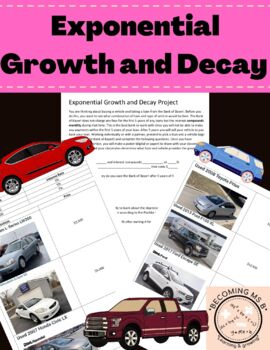Exponential Growth and Decay with Compound Interest Vehicle Buying Project
What educators are saying
Description
Introduce your students to the concept of exponential growth and decay in a real-world context with this interactive project!
Students will pick a vehicle from 6 preselected vehicles and a loan from 3 loan offers, calculate how much they owe the bank after 5 years and the value of the car, and create a poster to share their findings with their classmates.
Through this project, students will get practice calculating exponential growth and learn about the importance of borrowing wisely. A student reflection sheet is also included for students to use during the gallery walk of their peers' posters, helping them to understand the pros and cons of taking vehicle loans.
This project is a great way to engage students in creative and meaningful learning, as evidenced by the positive feedback I got from my students: "I liked that I got to do something creative while making the poster!" and "This project was very interesting! I hope we can do some more things like this."
Answer Keys included!


